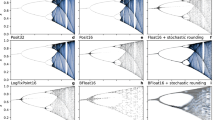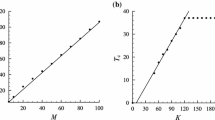Abstract
Using 1200 CPUs of the National Supercomputer TH-A1 and a parallel integral algorithm based on the 3500th-order Taylor expansion and the 4180-digit multiple precision data, we have done a reliable simulation of chaotic solution of Lorenz equation in a rather long interval 0 ⩽ t ⩽ 10000 LTU (Lorenz time unit). Such a kind of mathematically reliable chaotic simulation has never been reported. It provides us a numerical benchmark for mathematically reliable long-term prediction of chaos. Besides, it also proposes a safe method for mathematically reliable simulations of chaos in a finite but long enough interval. In addition, our very fine simulations suggest that such a kind of mathematically reliable long-term prediction of chaotic solution might have no physical meanings, because the inherent physical micro-level uncertainty due to thermal fluctuation might quickly transfer into macroscopic uncertainty so that trajectories for a long enough time would be essentially uncertain in physics.
Similar content being viewed by others
References
Lorenz E N. Deterministic non-periodic flow. J Atmos Sci, 1963, 20: 130–141
Lorenz E N. Computational chaos-a prelude to computational instability. Phys D, 1989, 15: 299–317
Lorenz E N. Computational periodicity as observed in a simple system. Tellus-A, 2006, 58: 549–559
Egolf D A, Melnikov V, Pesch W, et al. Mechanisms of extensive spatiotemporal chaos in Rayleigh-B`enard convection. Nature, 2000, 404: 733–735
Gaspard P, Briggs M E, Francis M K, et al. Experimental evidence for microscopic chaos. Nature, 1998, 394: 865–868
Anosov D V. Geodesic flows on closed Riemannian manifolds with negative curvature. Proc Steklov Inst Math, 1967, 90: 1
Dawson S, Grebogi C, Sauer T, et al. Obstructions to shadowing when a Lyapunov exponent fluctuates about zero. Phys Rev Lett, 1994, 73: 1927–1930
Sauer T, Grebogi C, Yorke J A. How long do numerical chaotic solutions remain valid? Phys Rev Lett, 1997, 79: 59–62
Sauer T. Shadowing breakdown and large errors in dynamical simulations of physical systems. Phys Rev E, 2002, 65: 036220
Yuan G, Yorke J A. Collapsing of chaos in one dimensional maps. Phys D, 2000, 136: 18
Shi P L. A relation on round-off error, attractor size and its dynamics in driven or coupled logistic map system. Chaos, 2008, 18: 013122
Li J P, Zeng Q G, Chou J F. Computational uncertainty principle in nonlinear ordinary differential equations (I): Numerical results. Sci China Ser E-Tech Sci, 2000, 43: 449–460
Li J P, Zeng Q G, Chou J F. Computational uncertainty principle in nonlinear ordinary differential equations (II): Theretical analysis. Sci China Ser E-Tech Sci, 2001, 44: 55–74
Teixeira J, Reynolds C A, Judd K. Time step sensitivity of nonlinear atmospheric models: Numerical convergence, truncation error growth, and ensemble design. J Atmos Sci, 2007, 64: 175–188
Liao, S J. On the reliability of computed chaotic solutions of non-linear differential equations. Tellus-A, 2009, 61: 550–564
Wang P F, Li J P, Li Q. Computational uncertainty and the application of a high-performance multiple precision scheme to obtaining the correct reference solution of Lorenz equations. Numer Algorithms, 2012, 59: 147–159
Corliss G F, Chang Y F. Solving ordinary differential equations using Taylor series. ACM Trans Math Software, 1982, 8: 114–144
Barrio R, Blesa F, Lara M. VSVO formulation of the Taylor method for the numerical solution of ODEs. Comput Math Appl, 2005, 50: 93–111
Liao S J. On the numerical simulation of propagation of micro-level inherent uncertainty for chaotic dynamic systems. Chaos Soliton Fractal, 2013, 47: 1–12
Saltzman B. Finite amplitude free convection as an initial value problem (I). J Atmos Sci, 1962, 19: 329–341
Khinchin A I. Mathematical Foundations of Statistical Mechanics. Dover Publications, 1949
Landau L D, Lifshitz EM. Statistical Physics. 3rd ed. Pergamon Press, 1985
Gorodetsky M L, Grudinin I S. Fundamental thermal fluctuations in microspheres. J Opt Soc Am B, 2004, 21: 697–705
Liao S J. Chaos: A bridge from microscopic uncertainty to macroscopic randomness. Commun Nonlinear Sci Numer Simulat, 2012, 17: 2564–2569
Liao S J. Physical limit of prediction for chaotic motion of three-body problem. Commun Nonlinear Sci Numer Simulat, 2014, 19: 601–616
Bai Y L, Ke F J, Xia M F. Deterministically stochastic behavior and sensitivity to initial configuration in damage fracture. Sci Bull, 1994, 39: 892–895
Xia M F, Ke F J, Wei Y J, et al. Evolution induced catastrophe in a nonlinear dynamical model of material failure. Nonlinear Dyn, 2000, 22: 205–224
Author information
Authors and Affiliations
Corresponding author
Rights and permissions
About this article
Cite this article
Liao, S., Wang, P. On the mathematically reliable long-term simulation of chaotic solutions of Lorenz equation in the interval [0,10000]. Sci. China Phys. Mech. Astron. 57, 330–335 (2014). https://doi.org/10.1007/s11433-013-5375-z
Received:
Accepted:
Published:
Issue Date:
DOI: https://doi.org/10.1007/s11433-013-5375-z




